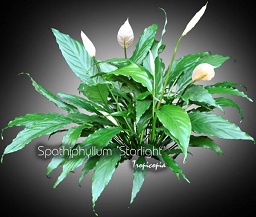Table of contents
Peace lily

Latin Name: Spathiphyllum ‘Starlight’
Category: Spathiphyllum
Family: Araceae
Origin: Cultivar
Climate: Tropical
Growing Zones: 11-10
Care Instructions
The Peace lily (Spathiphyllum ‘Starlight’) is a tropical plant that originates from Cultivar. This spathiphyllum plant belongs to the Araceae family and is well-suited for growing in USDA zones 11-10.
Complete Care Guide for Peace Lily (Spathiphyllum ‘Starlight’)
Watering Requirements
The Peace Lily, known for its lush green leaves and elegant white blooms, thrives best with consistent watering. It is essential to keep the soil evenly moist but not soggy. Water your Peace Lily when the top inch of soil feels dry to the touch. Typically, this means watering once a week, but this can vary based on environmental conditions such as humidity and temperature. During the growing season (spring and summer), you may need to increase the frequency, while in the dormant months (fall and winter), reduce watering. Overwatering can lead to root rot, so always ensure that the pot has drainage holes to allow excess water to escape.
Light Conditions
Peace Lilies prefer bright, indirect light but can also tolerate low-light conditions, making them ideal for indoor spaces. Direct sunlight can scorch their leaves, so it’s best to place them near a window with filtered light or in a well-lit room. If the leaves start to yellow, it may indicate that the plant is receiving too much light. Conversely, if the plant is not blooming, it might not be getting enough light. A balance is key; aim for a spot where the plant can receive bright, indirect sunlight for several hours a day.
Soil Preferences
Peace Lilies thrive in well-draining, rich potting soil. A mix that includes peat moss, perlite, and pine bark is ideal, as it retains moisture while allowing excess water to drain away. This type of soil provides the necessary nutrients for healthy growth. Fertilization should be done sparingly; use a balanced, water-soluble fertilizer diluted to half strength every 6-8 weeks during the growing season. Avoid fertilizing in the fall and winter when the plant is dormant, as this can lead to fertilizer burn and damage the roots.
Pests and Diseases
While Peace Lilies are relatively resilient, they can be susceptible to pests such as spider mites, aphids, and mealybugs. Regularly inspect the undersides of leaves for signs of infestation. If you notice pests, treat the plant with insecticidal soap or neem oil, ensuring to cover all surfaces of the leaves. Additionally, Peace Lilies can suffer from diseases like root rot, which is often caused by overwatering. Signs of root rot include wilting leaves and a foul smell from the soil. To prevent this, ensure proper drainage and allow the soil to dry out slightly between waterings.
Special Care Tips
To keep your Peace Lily healthy and thriving, consider the following special care tips: First, wipe the leaves with a damp cloth regularly to remove dust, which can hinder photosynthesis. Additionally, Peace Lilies enjoy humidity, so misting the leaves or placing a humidifier nearby can enhance their growth, especially in dry indoor environments. If your plant is not blooming, consider moving it to a brighter location or adjusting your watering schedule. Lastly, be cautious of the plant’s toxicity; Peace Lilies contain calcium oxalate crystals, which can be harmful if ingested by pets or humans. Keep the plant out of reach of curious pets and children.








